#Amulet Pendant
Text
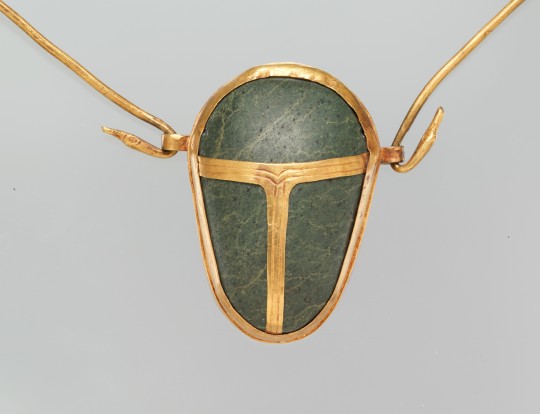
Ancient Egyptian heart amulet (gold and green schist) of one Manhata. Artist unknown; ca. 1479-1425 BCE (reign of Thutmose III, 18th Dynasty, New Kingdom). From the Tomb of the Three Foreign Wives of Thutmose III at Wadi Gabbanat el-Qurud, Thebes; now in the Metropolitan Museum of Art.
#art#art history#ancient art#Egypt#Ancient Egypt#Egyptian art#Ancient Egyptian art#Egyptian religion#Ancient Egyptian religion#kemetic#Thutmose III#18th Dynasty#New Kingdom#jewelry#jewellery#pendant#amulet#metalwork#gold#goldwork#schist#Egyptian Thebes#Metropolitan Museum of Art
694 notes
·
View notes
Text

Gold Pendant Amulet of Ptah
Late Period, ca. 664-332 BC.
Now in the Louvre. E 4949
49 notes
·
View notes
Text

Vintage Jewish Amulet w/ fitted case. Circa: 20th century.
Amulet size: approx. 9.8cm x 6.5cm
47 notes
·
View notes
Text

An ocean lives within its aqua hues. As you wear it, you feel the ebb and flow of its energy. Peaceful, it lulls me into watery daydream. Like the sea, it provides clarity, a space to sit and breathe. You watch the waves within its crystallized temple, finding answers in the blue depths. Aquamarine works with the throat chakra, providing fluid expression. The throat is where the truth flourishes. a sacred space of earth roots and cosmic wonder, our voice the passage between worlds.
AQUAMARINE: "Stone of the Sea,” It connects to the depths of the ocean, allowing you to reflect and find peace with your emotions. A magical stone that allows you to communicate with water spirits. Aquamarine strengthens communication with nature spirits, deepens intuition, and provides ocean energy.
Item: Large 55mm aquamarine cabochon framed in blackened sterling silver. Comes with an oxidized sterling silver 18” chain.
Purchase From My Shop: HERE
#crystals#wicca#pagan#druid#magick#witch#goddess#witchy#aquamarine crystal#aquamarine#amulet#crystal pendant#etsyseller#etsyshop#etsyfinds#etsystore#etsy#fae#throatchakra
20 notes
·
View notes
Text
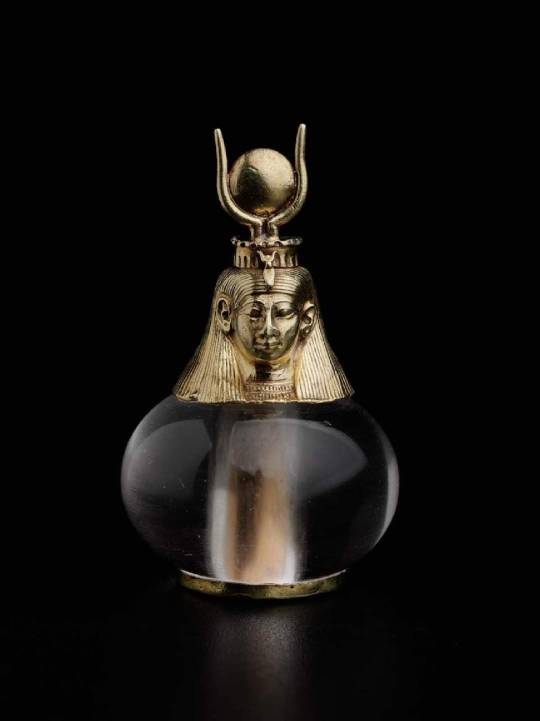
Nubian Hathor-headed Pendant,
Belonged to Napatan Period, reign of Piankhy (Piye), dated 743–712 BC, from Ku. 55, el-Kurru, Nubia (modern Sudan).
The Crystal ball amulet is surmounted by a gold head of Hathor crowned with disc and horns.
The Crystal ball is bored vertically and has a gold disc at the base on which it stands.
Probably contained substances believed to be magical. Ring at back of head.
Gold and Rock Crystal, 5.3 x 3.3cm,
Courtesy: MFA Boston
#art#history#design#style#archeology#sculpture#nubia#hathor#head#rock crystal#gold#pendant#napatan period#piye#sudan#amulet#magic#MFAboston#ku#el-kurru
36 notes
·
View notes
Text


Sterling Silver and Vaseline Uranium Glass Pendant
“Vintage Mexican sterling pendant necklace featuring a large emerald cut vaseline glass gem. Glows bright green under a blacklight indicating the presence of uranium in the glass. The gem is true vaseline and not just yellow uranium, having the telltale neon greenish glow in sunlight.”
173 notes
·
View notes
Text





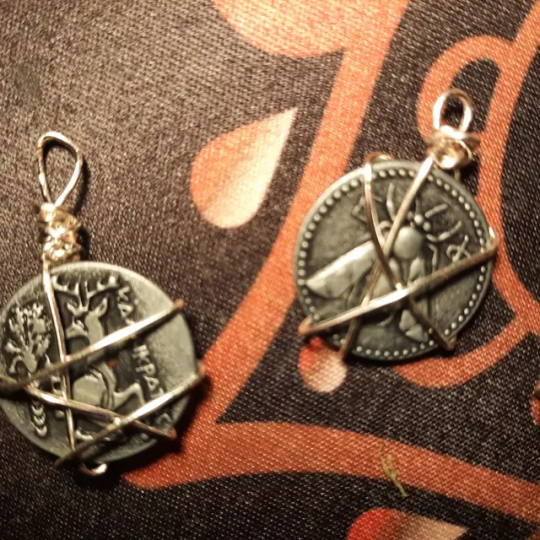



working on coins for the ferryman (Charon). these are gunna end up being necklaces, I think, but I'm going to make ones attached to lobster claws later.
#pagan witch#witchcraft#witchy vibes#witchblr#eclectic witch#Charon the ferryman#cthonic gods#psychopomp#talismanic jewelry#witch jewelry#jewelry#tumblr witches#witch aesthetic#witchy things#witches of tumblr#witch blog#witch stuff#witch store#online store#artist on kofi#kofi#etsy#amulet#talisman#protection magic#safe passage#wire wrapped pendant#wire wrapped jewelry#etsy shop#queer artist
7 notes
·
View notes
Text
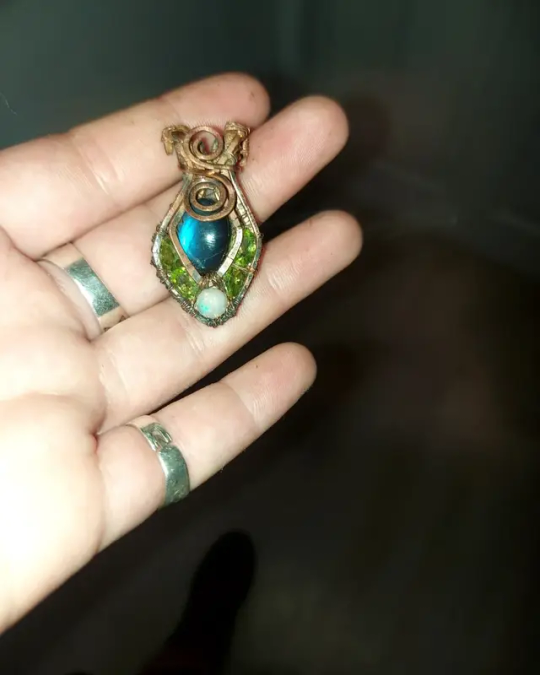
This looks like a sea witch amulet 💙
Blue Labradorite nestled in hammered copper wire with 4 faceted peridot ovals and 1 round Ethiopian Opal.
Oxidized and polished for an antique look.
This piece radiates such magical and spiritual energy.
#crystals#witchblr#magick#pagan#wire wrapped jewelry#witch craft#witchcore#wire art#wire wrapped pendant#witch community#amulet#witch#witchcraft#crystal healing#crystal magic#labradorite#peridot#opal#opal jewelry
22 notes
·
View notes
Text
Such medieval "reliquaries" — containers or shrines for the bones or other relics of saints. This pendant is a phylactery — a type of amulet — that housed saintly relics and was supposed to give protection to those who wore it
The Garbage pit it was found is in a court at a noble palace that dated from the High Baroque period in the early 17th century. Though it contained mostly pottery, the pendant was found in a layer of the pit that dated to the 14th century.
Pendant's distinctive artistic style of the pendant suggests that it dates to the 12th century, and that it was already old when it was thrown away.Probably crafted in the workshop near the city of Hanover, about 175 miles north of Mainz, that is known to have made similar objects.
#history#archeology#archeologicalsite#discovery#medieval#middle ages#pendant#reliquary#amulet#German#cath#catholic
21 notes
·
View notes
Text
Pendant of Daydreams by Mysterious Trove


#mysterious trove#pendant#daydreams#magic items#rare#amulet#amulets#talisman#talismans#illusion#spellcasting#arcane#focus#resting
19 notes
·
View notes
Text
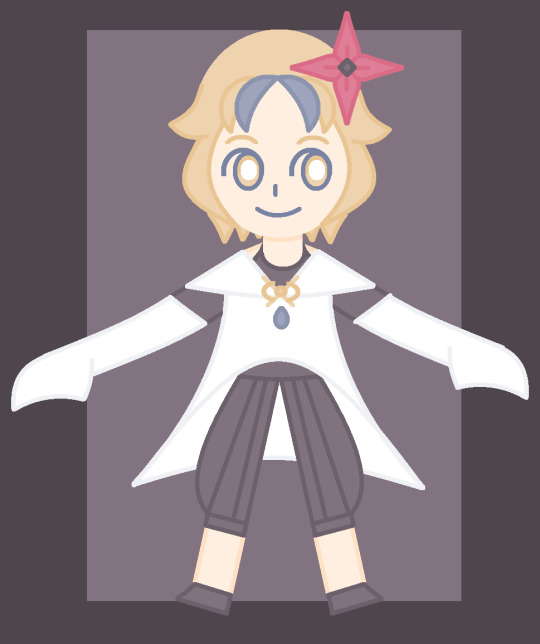
Eternal Flower, Acro Cogita
Nephew of Miss Cogita- and the unknown younger cousin of Volo Cogita.
Born in a secluded village in Kalos, surrounded by sentries of psychic-type Pokemon- particularly, the entirety of the Ralts line.
As the only child in his village, he is considered a blessing, and the village's treasure- however, since he's surrounded by grown-ups and elders, he adapts their way of thinking and speech at a young age.
Devout follower and believer of Arceus, even more so than the elders who are raising him. He wears only the robes and rejects most of his Aunt Cogita's gifts in favor of living a simplistic lifestyle- though he wears a tear-drop shaped pendant.
Cleans the temple devoted to Arceus daily, as well as prays often. When he's not serving Arceus, he's reading books brought to him by his aunt, or picking berries and flowers in the outskirts of the village.
He's picked (and worn) a rare coloration of a Kalosian flower that is said to symbolize eternal life.
His only playmates consist of Elgyem, Wynaut, Mime Jr., and Espurr. Often guarded by a Woobat, Indeedee, Gardevoir, and Gallade.
#BW/BW2 Rewrite - Blur / Blight#My Art#((NIKOLAI WEARS THE SAME CLOTHES WHEN HES OLDER but he wears the robe to hang off of his shoulders.))#((And the pendant is attached to a choker he wears around his neck. It's an amulet to him.))#((And no more flower tucked into his hair but. Oops. HE becomes the Eternal Flower. Sorry Nikolai.))#((Wanted to give him something that could connect him to his Aunt Cogita + cousin Volo so. Teardrop shaped pendant.))#((And his clothes are rather simple..))#((He's around 8-10 here!))#((Also this is like a Little Cheri situation. He/they pronouns for Acro/Nikolai but like. The villagers don't know if he's a boy or girl.))#(( <- Nikolai in-universe is technically genderfluid but he doesn't know what that is ))
8 notes
·
View notes
Text
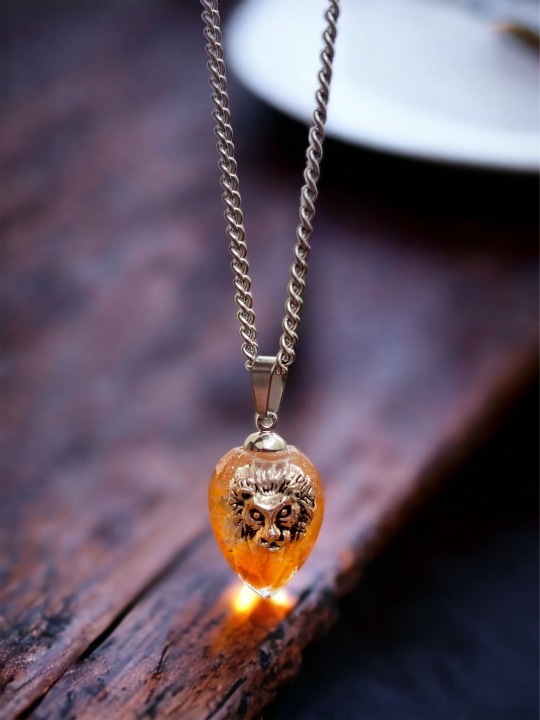
Carnelian Lion
#FBTMN#foragednaturedesigns#handmade jewelry#original content#crystal#original art#fantasy#magical#leo sign#astrology#carnelian#carnelian crystal#leo sun#amulet#lion#orange#crystal pendant#jewelers of tumblr#artist on tumblr
9 notes
·
View notes
Text

Golden Ram's-head Amulet
This amulet was probably made for a necklace worn by one of the Kushite kings. Representations show these pharaohs wearing a ram's-head amulet tied around the neck on a thick cord, the ends of which fall forward over the shoulders. Sometimes a smaller ram's head is attached to each end. Rams were associated with the god Amun, particularly in Nubia, where he was especially revered.
During the 25th Dynasty of ancient Egypt, also known as the Kushite Dynasty, ram pendants continued to be popular symbols of power, protection, and divine connection. The Kushite rulers, who were of Nubian descent, incorporated elements of both Egyptian and Nubian culture into their jewelry and artifacts. Ram pendants during this period may have featured a blend of Egyptian and Nubian artistic styles, reflecting the cultural fusion of the time. These pendants likely held similar symbolic meanings as in earlier periods, representing strength, fertility, and the divine authority of the rulers.
Third Intermediate Period, 25th Dynasty, ca. 712-664 BC.
Possibly from Nubia.
Now in the Metropolitan Museum of Art. 1989.281.98
Read more
48 notes
·
View notes
Text

4th pentacle of venus
#witchblr#witchcraft#witch#solomon#solomon seal#seal of solomon#venus#amulet#pendant#talisman#love#love witch
9 notes
·
View notes
Text
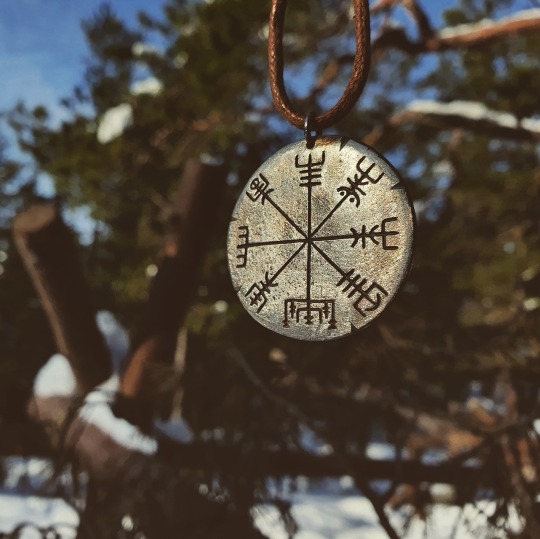
#vegvisir pendant#titibaka etsy#norse mythology#pagan#heathen#asatru#norse#viking art#vegvisir amulet#vegvisir silver
63 notes
·
View notes
Text

The Tyet, also known as the Knot of Isis, is a symbol that translates as “welfare” or “life.” The tyet iconography first appears in the 3rd dynasty, yet is believed to originate around Predynastic period.
The association with goddess Isis did not appear until later in Egyptian history. Knots were commonly used as amulets to symbolize the bound and release of magic. This knot was associated with the goddesses: Nut, Hathor, Nephthys, and Isis.
It was common place to place the tyet around the deceased neck. The tyet was often made out of stones like carnelian, red jasper and/or red glass. The red stones were said to protect the dead and in the NK, BotD spell, it states that the jed jasper tyet would “drive away those who would commit crimes against them.” The Tyet was also made out of green faience, too, though, and this was to symbolize the renewal of life.
It is typically seen paired with the Djed pillar, a symbol that was often associated with Osiris- most commonly with the spine of Osiris. How could you support yourself without welfare in line with it?
Image from: https://www.metmuseum.org/art/collection/search/548207
#egyptian mythology#kemetic#kemetic paganism#kemetism#ancient egypt#ancient kemet#tyet#knot of isis#girdle of isis#blood of isis#egyptian history#amulet#protection amulet#egyptian pendant#isis#nut#hathor#nephthys#protection
7 notes
·
View notes